Synthesis and properties of EPDM-based oil-absorptive gels with different types of EPDM and styrene derivatives
Abstract
A series of oil gels based on different types of ethylene–propylene–diene (EPDM) and styrene derivatives crosslinked with divinylbenzene (DVB) were synthesized by suspension polymerization. Effects of EPDM types and styrene derivatives on gel fraction, swelling ratio (q), solubility parameter (δ), average molecular weight between cross-links (Mc), and oil absorption and oil retention of EPDM-based oil-absorptive gels were studied. Characterization of EPDM-based oil-absorptive gels with different styrene derivatives was performed by Fourier transform infrared (FTIR) spectroscopy, scanning electron microscopy (SEM), and oil absorbency tests. The results showed that the double bond of the EPDM side chains was crosslinked with 4-tert-butyl styrene (t-BS), α-methyl styrene (α-MSt), styrene (St) or 4-methyl styrene (4-MSt) to form a three-dimensional network structure, respectively. Compared with the other three EPDM-based oil-absorptive gels, t-BS–EPDM–DVB (ESSB) has the best oil absorption and oil retention, which is mainly due to the fact that the substituent of t-BS is much larger than those of St, 4-MSt and α-MSt. The maximum oil absorption of the ESSB in chloroform was 23 g g−1. This investigation clearly distinguishes the influence of the synthetic raw materials of the EPDM-based oil-absorptive gels on their properties under study, which helps to optimize EPDM-based oil-absorptive materials according to actual applications.



 Please wait while we load your content...
Please wait while we load your content...